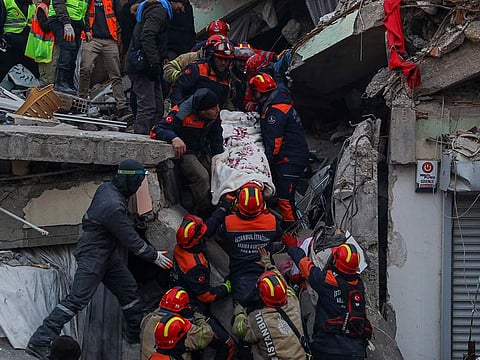Turkey-Syria quake: Survivors still being found as death toll tops 25,000
Dramatic rescues broadcast on Turkish television, including the rescue of the Narli family

ANTAKYA, Turkey : Rescue crews on Saturday pulled more survivors, including entire families, from toppled buildings despite diminishing hopes as the death toll of the enormous quake that struck a border region of Turkey and Syria five days ago surpassed 25,000.
Dramatic rescues were being broadcast on Turkish television, including the rescue of the Narli family in central Kahramanmaras 133 hours after the 7.8-magnitude temblor struck Monday.
First, 12-year-old Nehir Naz Narli was saved, then both of her parents.
That followed the rescue earlier in the day of a family of five from a mound of debris in the hard-hit town of Nurdagi, in Gaziantep province, TV network HaberTurk reported. Rescuers cheered and chanted, as the last family member, the father, was lifted to safety.
Turkish President Recep Tayypi Erdogan, on a tour of quake-stricken cities, raised the death toll in Turkey to 21,848, which pushed the total number of dead across the region, including government and rebel-held parts of Syria, to 25,401.
Erdogan said a disaster of this scope is rare, affecting an area so large that is home to so many people. He referred to it as the “disaster of the century” and said it had affected an area 500 kilometers (310 miles) in diameter that is home to 13.5 million people in Turkey and an unknown number in Syria.
“In some parts of our settlements close to the fault line, we can say that almost no stone was left standing,'' he said earlier Saturday from Diyarbakir.
More lives saved
Still, the day brought one astonishing rescue after another, numbering more than a dozen.
Melisa Ulku, a woman in her 20s, was extricated from the rubble in Elbistan in the 132th hour since the quake, following the rescue of another person at the same site in the same hour. Ahead of her rescue, police announced that people shouldn’t cheer or clap in order to not interfere with other rescue efforts nearby. She was covered in a thermal blanket on a stretcher. Rescuers were hugging.
Just an hour earlier, a 3-year-old girl and her father were pulled from debris in the town of Islahiye, also in Gaziantep province, and soon after a 7-year-old girl was rescued in the province of Hatay.
Shimmers of joy amidst devastation
The rescues brought shimmers of joy amid overwhelming devastation days after Monday’s 7.8-magnitude quake and a powerful aftershock hours later caused thousands of buildings to collapse, killing more than 25,000, injuring another 80,000 and leaving millions homeless.
Not everything ended so well. Rescuers reached a 13-year-old girl inside the debris of a collapsed building in Hatay province early Saturday and intubated her. But she died before the medical teams could amputate a limb and free her from the rubble, Hurriyet newspaper reported.
Even though experts say trapped people can live for a week or more , the odds of finding more survivors were quickly waning amid freezing temperatures. Rescuers were shifting to thermal cameras to help identify life amid the rubble , a sign that any remaining survivors could be too weak to call for help.
Indian army sets up field hospital
As aid continued to arrive, a 99-member group from the Indian Army’s medical assistance team began treating the injured in a temporary field hospital in the southern city of Iskenderun, where a main hospital was demolished.
One man, Sukru Canbulat, was wheeled into the hospital in a wheelchair, his left leg badly injured with deep bruising, contusions and lacerations.
Wincing in pain, he said he had been rescued from his collapsed apartment building in the nearby city of Antakya within hours of the quake on Monday. But after receiving basic first aid, he was released without getting proper treatment for his injuries.
″I buried (everyone that I lost), then I came here,’’ Canbulat said, counting his dead relatives: “My daughter is dead, my sibling died, my aunt and her daughter died, and the wife of her son" who was 8 ½ months pregnant.
Sad sight
A large makeshift graveyard was under construction on the outskirts of Antakya on Saturday. Backhoes and bulldozers dug pits in the field on the northeastern edge of the city as trucks and ambulances loaded with black body bags arrived continuously. Soldiers directing traffic on the busy adjacent road warned motorists not to take photographs.
The hundreds of graves, spaced no more than 3 feet (a meter) apart, were marked with simple wooden planks set vertically in the ground.
A worker with Turkey’s Ministry of Religious Affairs who did not wish to be identified because of orders not to share information with the media said that around 800 bodies were brought the cemetery on Friday, its first day of operation. By midday on Saturday, he said, as many as 2,000 had been buried.
“People who are coming out from the rubble now, it’s a miracle if they survive. Most of the people that come out now are dead, and they come here,” he said.
Temperatures remained below freezing across the large region, and many people have no shelter. The Turkish government has distributed millions of hot meals, as well as tents and blankets, but is still struggling to reach many people in need.
Sign up for the Daily Briefing
Get the latest news and updates straight to your inbox



